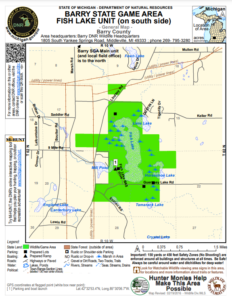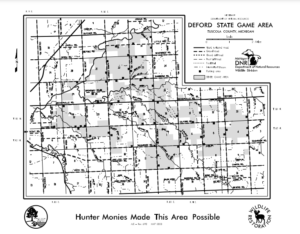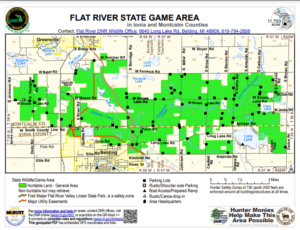Enjoyable State Game Areas
Michigan is in full bloom, everything is green, and the weather is wonderful. Summer is the perfect time to explore the outdoors. There are many ways to enjoy nature, such as bird watching, hiking, foraging, fishing and boating. The presence of protected wildlife areas gives us access to these activities and protects wilderness for years to come.
There are many State Game Areas in Michigan. The purpose of a State Game Area is to conserve habitat and provide areas for hunting and trapping. These State Game Areas are dedicated to wildlife conservation and management.
Barry State Game Area:

This game area consists of 16,692 acres located in Barry County. The primary cover type is a mixed forest dominated by oak trees. Wetlands and conifer forests are also found throughout the landscape. White-tailed deer, wild turkeys, cottontail rabbits, squirrels, wood cock and ruffed grouse are the game species managed in the area. A project improving the longevity of the forest by supporting the growth of seedlings and maintaining older trees ensures the continued presence of healthy populations of game species. Game management practices also positively influence other wildlife species. Fens and wetlands in the area support Mitchell’s satyr butterfly, an endangered species. Rabbitat built to make quality living spaces for small game species also support nesting habitat for the Cerulean warbler, a threatened songbird in Michigan.
Deford State Game Area:

10,390 acres of aspen conifer mixed forest and open grassy areas located in Sanilac and Tuscola counties make up the Deford State Game Area. Currently, the management plan highlights white-tailed deer, cottontail rabbits, ruffed grouse, woodcock and wild turkeys. Trapping is popular in the area, mink, raccoon, muskrat, fox, coyote, beaver and otter make up the fur-bearing species. Transforming the area from abandoned sandy farmland into pine forests and grasslands made valuable habitat for game species as well as the red-shoulder hawk, northern goshawk and the cerulean warbler.
Flat River State Game Area:
 Located in Ionia and Montcalm Counties 11,235 acres of oak savanna and wetlands make up the Flat River State Game Area. Game species include wild turkeys, wood ducks, white-tailed deer, grouse, cottontail rabbits and woodcock. Many creeks and wetlands make the state game area a popular waterfowl hunting site. The wetlands are also an important habitat for many endangered butterfly species. One, in particular, the Karner blue butterfly, inhabits the area. Invasive species removal is a primary habitat objective to make the area viable for game species, which also benefits the endangered butterfly.
Located in Ionia and Montcalm Counties 11,235 acres of oak savanna and wetlands make up the Flat River State Game Area. Game species include wild turkeys, wood ducks, white-tailed deer, grouse, cottontail rabbits and woodcock. Many creeks and wetlands make the state game area a popular waterfowl hunting site. The wetlands are also an important habitat for many endangered butterfly species. One, in particular, the Karner blue butterfly, inhabits the area. Invasive species removal is a primary habitat objective to make the area viable for game species, which also benefits the endangered butterfly.
State Game Areas can be found throughout the southern lower peninsula of Michigan. If you would like to help with a habitat improvement project in a state game area near you, volunteer with MUCC’s On The Ground program . To learn more about the State Game Areas in Michigan, click HERE .
The post Enjoyable State Game Areas appeared first on Michigan United Conservation Clubs.



